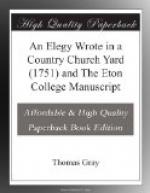All these changes illustrate the quality of Gray’s curious felicity. His assault on the reader’s sensibilities was organized and careful: here is no sign of that contradiction in terms, “unpremeditated art.” He probably did not work on the poem so long as historians have said he did, but he scanted neither time nor attention. Mason thought the poem begun and perhaps finished in 1742, and he connected its somberness with Gray’s great sorrow over the death of his close friend Richard West. All this seems more than doubtful: to Dr. Thomas Wharton in September 1746 Gray mentioned recently composing “a few autumnal verses,” and there is no real evidence of work on the poem before this time. Walpole evidently inclined to 1746 as the date of commencement, and it may be pointed out that Mason himself is not so sure of 1742 as have been his Victorian successors. All he says is, “I am inclined to believe that the Elegy ... was begun, if not concluded, at this time [1742] also.” Gray’s reputation for extreme leisurely composition depends largely on the “inclination” to believe that the “Elegy” was begun in 1742 and on a later remark by Walpole concerning Gray’s project for a History of Poetry. In a letter of 5 May 1761 Walpole joked to Montagu saying that Gray, “if he rides Pegasus at his usual foot-pace, will finish the first page two years hence.” Not really so slow as this remark suggests, Gray finally sent his “Elegy” to Walpole in June of 1750, and in December he sent perhaps an earlier form of the poem to Dr. Wharton. Naturally delighted with the perfected utterance of this finely chiseled work, these two friends passed it about in manuscript, and allowed copies to be taken.
Publication, normally abhorrent to Gray, thus became inevitable, though apparently not contemplated by Gray himself. The private success of the poem was greater than he had anticipated, and in February of 1751 he was horrified to receive a letter from the editor of a young and undistinguished periodical, “The Magazine of Magazines,” who planned to print forthwith the “ingenious poem, call’d Reflections in a Country-Churchyard.” Gray hastily wrote to Walpole (11 February), insisting that he should “make Dodsley print it immediately” from Walpole’s copy, without Gray’s name, but with good paper and letter. He prescribed the titlepage as well as other details, and within four days Dodsley had the poem in print, and anticipated the piratical “Magazine” by one day. But the “Magazine” named Gray as the author, and success without anonymity was the fate of the “Elegy.” Edition followed edition, and the poem was almost from birth an international classic.




